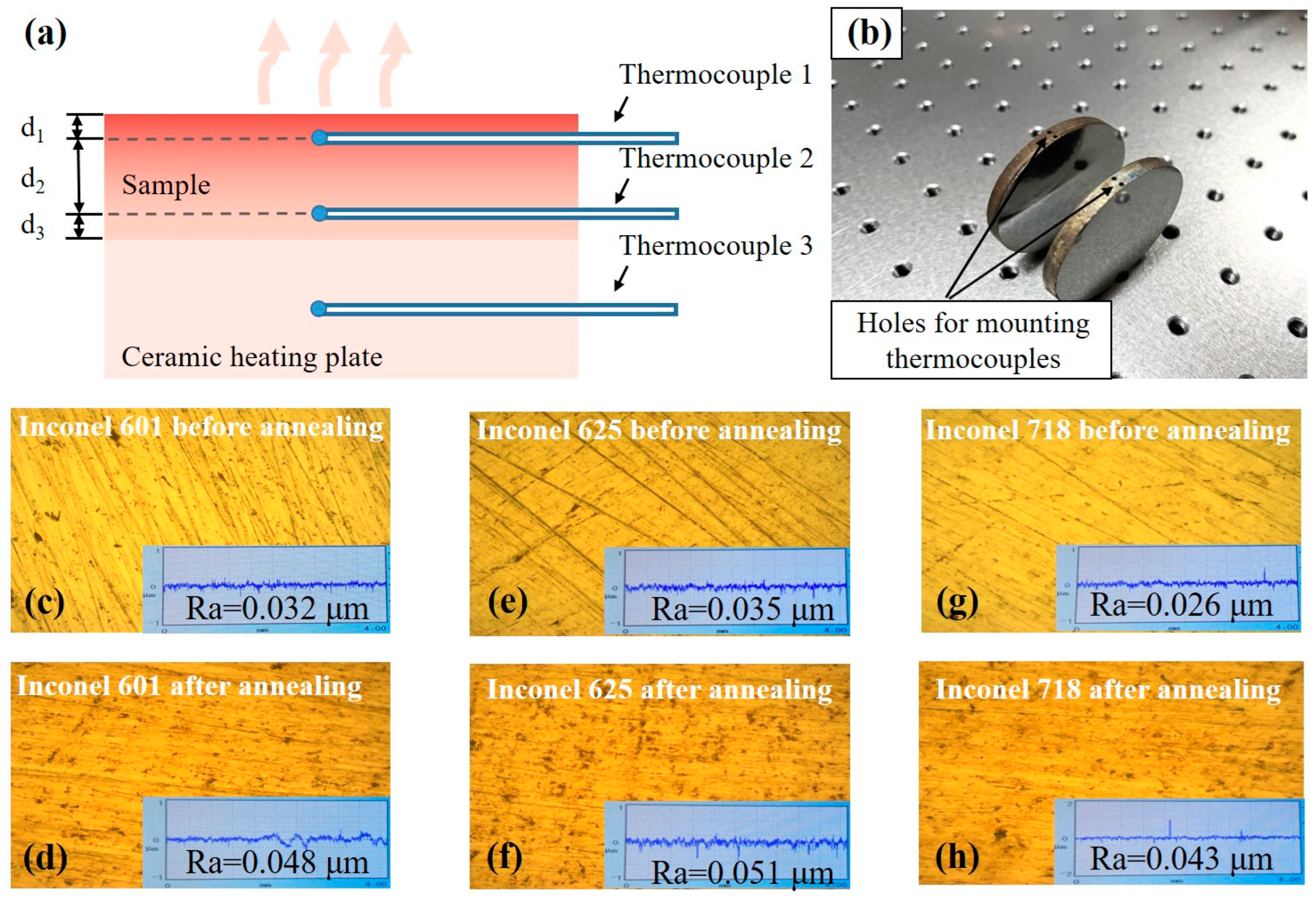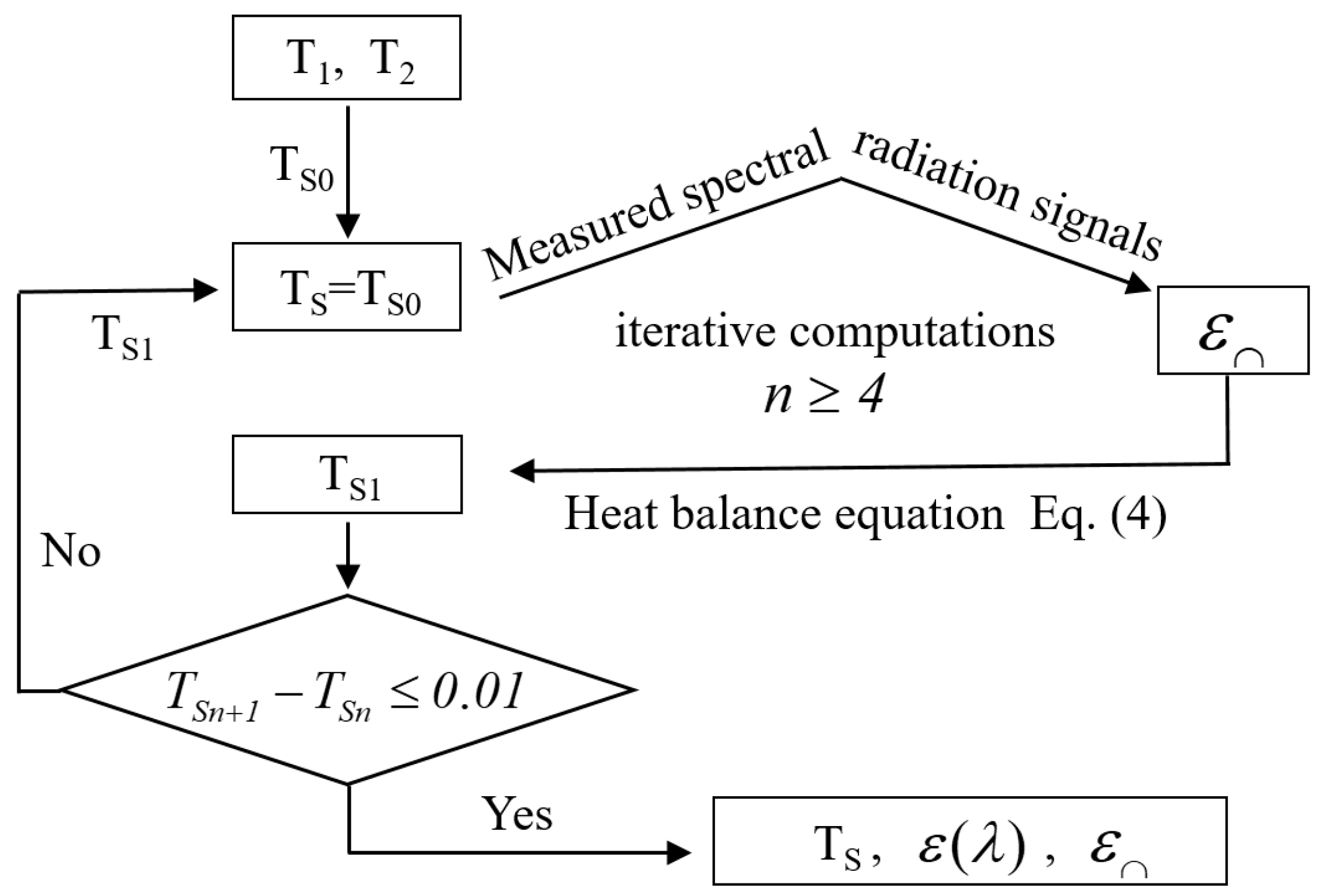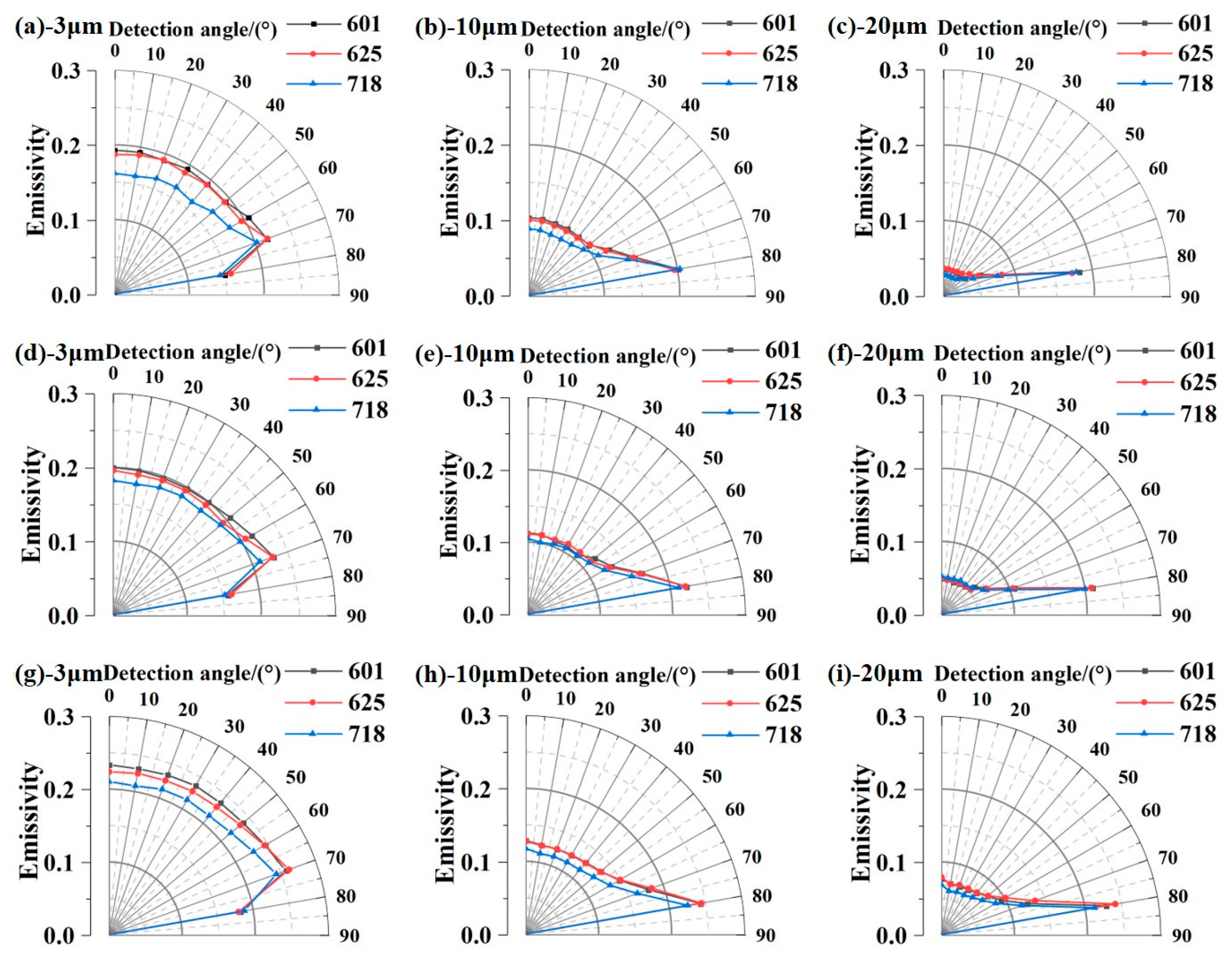Accurately Measuring the Infrared Spectral Emissivity of Inconel 601, Inconel 625, and Inconel 718 Alloys during the Oxidation Process
Abstract
:1. Introduction
2. Surface Temperature Calculation Method
3. Samples
4. Device and Method for Measuring Spectral Emissivity
5. Measurement Procedure
6. Measurement Results and Analysis
6.1. Spectral Emissivity of Inconel 601, Inconel 625, and Inconel 718 at Different Temperatures, Wavelengths, and Zenith Angles
6.2. Effect of Wavelength on the Emissivity of Inconel 601, Inconel 625, and Inconel 718
6.3. Effect of Zenith Angle on the Emissivity of Inconel 601, Inconel 625, and Inconel 718
6.4. Effect of Thermal Oxidation on the Spectral Emissivity of Inconel 601, Inconel 625, and Inconel 718
6.5. Uncertainty Evaluation
7. Conclusions
Author Contributions
Funding
Institutional Review Board Statement
Informed Consent Statement
Data Availability Statement
Acknowledgments
Conflicts of Interest
References
- Hosseini, E.; Popovich, V.A. A review of mechanical properties of additively manufactured Inconel 718. Addit. Manuf. 2019, 30, 100877. [Google Scholar] [CrossRef]
- Ceritbinmez, F.; Günen, A.; Gürol, U.; Çam, G. A comparative study on drillability of Inconel 625 alloy fabricated by wire arc additive manufacturing. J. Manuf. Process. 2023, 89, 150–169. [Google Scholar] [CrossRef]
- Parizia, S.; Marchese, G.; Rashidi, M.; Lorusso, M.; Hryha, E.; Manfredi, D.; Biamino, S. Effect of heat treatment on microstructure and oxidation properties of Inconel 625 processed by LPBF. J. Alloys Compd. 2020, 846, 156418. [Google Scholar] [CrossRef]
- Gao, S.; Zhang, X.; Chen, L.; Cui, Y.; Jiang, J.; Zhang, Z.; Yu, P.; Wang, C. Review: Radiation temperature measurement methods for engine turbine blades and environment influence. Infrared Phys. Technol. 2022, 123, 104204. [Google Scholar] [CrossRef]
- Huang, X.K.; Chai, Z.; Ren, X.K.; Chen, X.Q. A modified infrared emissivity model accurately determining dynamic temperatures for belt grinding Inconel 718. J. Manuf. Process. 2023, 101, 86–103. [Google Scholar] [CrossRef]
- Kopec, M. Recent Advances in the Deposition of Aluminide Coatings on Nickel-Based Superalloys: A Synthetic Review (2019–2023). Coatings 2024, 13, 769. [Google Scholar] [CrossRef]
- Del Campo, L.; Pérez-Sáez, R.B.; González-Fernández, L.; Esquisabel, X.; Fernández, I.; González-Martín, P.; Tello, M.J. Emissivity measurements on aeronautical alloys. J. Alloys Compd. 2010, 489, 482–487. [Google Scholar] [CrossRef]
- Kong, B.; Li, T.; Eri, Q.T. Normal spectral emissivity measurement on five aeronautical alloys. J. Alloys Compd. 2017, 703, 125–138. [Google Scholar] [CrossRef]
- Wang, C.; Zhang, Z.; Yu, P.; Duan, Y.; Niu, Y.; Jiang, J. Normal spectral emissivity study for GH3044 alloy and Ti-6Al-4V alloy. Infrared Phys. Technol. 2022, 125, 104278. [Google Scholar] [CrossRef]
- Qi, J.L.; Eri, Q.T.; Kong, B.; Zhang, Y.F. The radiative characteristics of inconel 718 superalloy after thermal oxidation. J. Alloys Compd. 2021, 854, 156414. [Google Scholar] [CrossRef]
- Colas, J.; Charpentier, L.; Balat-Pichelin, M. Oxidation in Air at 1400 K and Optical Properties of Inconel 625, FeCrAlloy and Kanthal Super ER. Oxid. Met. 2020, 93, 355–370. [Google Scholar] [CrossRef]
- Balat-Pichelin, M.; Sans, J.L.; Bêche, E.; Charpentier, L.; Ferrière, A.; Chomette, S. Emissivity at high temperature of Ni-based superalloys for the design of solar receivers for future tower power plants. Sol. Energy Mater. Sol. Cells 2021, 227, 111066. [Google Scholar] [CrossRef]
- Zhao, S.N.; Li, X.F.; Huai, X.L.; Zhou, X.M.; Cheng, K.Y. The normal spectral emission characteristics of Ni-based alloys during oxidation at high temperatures. Int. J. Heat Mass Transf. 2019, 128, 378–391. [Google Scholar] [CrossRef]
- Honnerová, P.; Martan, J.; Kučera, M.; Honner, M.; Hameury, J. New experimental device for high-temperature normal spectral emissivity measurements of coatings. Meas. Sci. Technol. 2014, 25, 095501. [Google Scholar] [CrossRef]
- Wang, P.; Hu, Z.; Xie, Z.; Yan, M. A new experimental apparatus for emissivity measurements of steel and the application of multi-wavelength thermometry to continuous casting billets. Rev. Sci. Instrum. 2018, 89, 054903. [Google Scholar] [CrossRef]
- Hatzl, S.; Kirschner, M.; Lippig, V.; Sander, T.; Mundt, C.; Pfitzner, M. Direct Measurements of Infrared Normal Spectral Emissivity of Solid Materials for High-Temperature Applications. Int. J. Thermophys. 2013, 34, 2089–2101. [Google Scholar] [CrossRef]
- Guo, Y.M.; Pang, S.J.; Luo, Z.J.; Shuai, Y.; Tan, H.P.; Qi, H. Measurement of Directional Spectral Emissivity at High Temperatures. Int. J. Thermophys. 2019, 40, 10. [Google Scholar] [CrossRef]
- Xiao, L.; Ma, H.; Liu, J.; Zhao, W.; Jia, Y.; Zhao, Q.; Liu, K.; Wu, Y.; Wei, Y.; Fan, S.; et al. Fast Adaptive Thermal Camouflage Based on Flexible VO2/Graphene/CNT Thin Films. Nano Lett. 2015, 15, 8365–8370. [Google Scholar] [CrossRef]
- Yuan, Z.; Yu, K.; Li, L.; Wang, G.; Zhang, K.; Liu, Y. New directional spectral emissivity measurement apparatus simultaneously collecting the blackbody and sample radiation. Rev. Sci. Instrum. 2022, 93, 044902. [Google Scholar] [CrossRef]
- Monte, C.; Hollandt, J. The determination of the uncertainties of spectral emissivity measurements in air at the PTB. Metrologia 2010, 47, S172–S181. [Google Scholar] [CrossRef]
- Houtz, D.A.; Gu, D.Z. A Measurement Technique for Infrared Emissivity of Epoxy-Based Microwave Absorbing Materials. IEEE Geosci. Remote Sens. Lett. 2018, 15, 48–52. [Google Scholar] [CrossRef]
- Lucchesi, C.; Delmas, A. Experimental setup for direct measurements of spectral directional emissivity from 0° to 80° angles at temperatures as low as 40 °C. Int. J. Therm. Sci. 2023, 185, 108045. [Google Scholar] [CrossRef]
- Korkmaz, M.E.; Gupta, M.K.; Yilmaz, H.; Ross, N.S.; Boy, M.; Sivalingam, V.K.; Chan, C.K.; Raman, J. Towards specific cutting energy analysis in the machining of Inconel 601 alloy under sustainable cooling conditions. J. Mater. Res. Technol.-JmrT 2023, 27, 4074–4087. [Google Scholar] [CrossRef]
- Manikandan, K.; Kumar, P.R.; Kumar, D.R.; Palanikumar, K. Machinability evaluation and comparison of Incoloy 825, Inconel 603 XL, Monel K400 and Inconel 600 super alloys in wire electrical discharge machining. J. Mater. Res. Technol.-JmrT 2020, 9, 12260–12272. [Google Scholar] [CrossRef]
- Qiao, L.; Bao, A.; Wang, Y.; Liu, Y.; Lai, Z.; Zhu, J. Thermophysical properties and high temperature oxidation behavior of FeCrNiAl0.5 multi-component alloys. Intermetallics 2020, 126, 106899. [Google Scholar] [CrossRef]
- Li, L.; Yu, K.; Zhang, K.; Liu, Y.; Zhang, F.; Liu, Y. Accuracy improvement for directional polarized spectral emissivity measurement in the wavelength range of 4–20 μm. Exp. Therm. Fluid Sci. 2021, 125, 110379. [Google Scholar] [CrossRef]
- Teodorescu, G.; Jones, P.D.; Overfelt, R.A.; Guo, B. Normal emissivity of high-purity nickel at temperatures between 1440 and 1605 K. J. Phys. Chem. Solids 2008, 69, 133–138. [Google Scholar] [CrossRef]
- De Arrieta, I.G.; Echániz, T.; Olmos, J.M.; Fuente, R.; Urcelay-Olabarria, I.; Igartua, J.M.; Tello, M.J.; López, G.A. Evolution of the infrared emissivity of Ni during thermal oxidation until oxide layer opacity. Infrared Phys. Technol. 2019, 97, 270–276. [Google Scholar] [CrossRef]
- del Campo, L.; Pérez-Sáez, R.B.; Tello, M.J.; Esquisabel, X.; Fernández, I. Armco iron normal spectral emissivity measurements. Int. J. Thermophys. 2006, 27, 1160–1172. [Google Scholar] [CrossRef]
- González-Fernández, L.; Risueño, E.; Pérez-Sáez, R.B.; Tello, M.J. Infrared normal spectral emissivity of Ti-6Al-4V alloy in the 500–1150 K temperature range. J. Alloys Compd. 2012, 541, 144–149. [Google Scholar] [CrossRef]
- Iuchi, T.; Furukawa, T.; Wada, S. Emissivity modeling of metals during the growth of oxide film and comparison of the model with experimental results. Appl. Opt. 2003, 42, 2317–2326. [Google Scholar] [CrossRef] [PubMed]
- del Campo, L.; Pérez-Sáez, R.B.; Esquisabel, X.; Fernández, I.; Tello, M.J. New experimental device for infrared spectral directional emissivity measurements in a controlled environment. Rev. Sci. Instrum. 2006, 77, 113111. [Google Scholar] [CrossRef]
- Wang, C.; Hu, J.; Wang, F.; Jiang, J.; Zhang, Z.Z.; Yang, Y.; Ding, J.X.; Jiang, H.C.; Wang, Y.M.; Wei, H.Y. Measurement of Ti–6Al–4V alloy ignition temperature by reflectivity detection. Rev. Sci. Instrum. 2018, 89, 044902. [Google Scholar] [CrossRef] [PubMed]







| Elements/% | Ni | Cr | Fe | Mo | Nb |
|---|---|---|---|---|---|
| Inconel 718 | 50.0–55.0 | 17.0–21.0 | 11.1–24.6 | 2.8–3.3 | 4.75–5.50 |
| Inconel 625 | 54.9–68.9 | 20.0–23.0 | Max.5.0 | 8.0–10.0 | 3.15–4.15 |
| Inconel 601 | 58.0–63.0 | 21.0–25.0 | 7.7–20.0 | / | / |
| Elements/% | C | Mn | Si | S | Cu |
| Inconel 718 | Max.0.08 | Max.0.35 | Max.0.35 | Max.0.015 | Max.0.30 |
| Inconel 625 | Max.0.1 | Max.0.5 | Max.0.5 | Max.0.015 | / |
| Inconel 601 | Max.0.1 | Max.1.0 | Max.0.5 | Max.0.015 | Max.1.0 |
| Elements/% | Al | Ti | B | Co | P |
| Inconel 718 | 0.2–0.8 | 0.65–1.15 | Max.0.006 | Max.1.0 | Max.0.015 |
| Inconel 625 | Max.0.4 | Max.0.4 | / | Max.1.0 | Max.0.015 |
| Inconel 601 | 1.0–1.7 | / | / | / | / |
| Parameters | T = 673 K | T = 873 K | ||
|---|---|---|---|---|
| = 3 μm = 0.187 | = 10 μm = 0.099 | = 3 μm = 0.239 | = 10 μm = 0.134 | |
| 0.058 | 0.030 | 0.054 | 0.029 | |
| 0.217 | 0.102 | 0.547 | 0.125 | |
| 0.081 | 0.137 | 0.113 | 0.168 | |
| 0.061 | 0.076 | 0.062 | 0.082 | |
| 0.018 | 0.020 | 0.021 | 0.027 | |
| 0.003 | 0.003 | 0.003 | 0.003 | |
| 0.246 | 0.189 | 0.565 | 0.227 | |
| 1.318 | 1.913 | 2.362 | 1.692 | |
| Parameters | T = 673 K | T = 873 K | ||
|---|---|---|---|---|
| = 3 μm = 0.184 | = 10 μm = 0.098 | = 3 μm = 0.234 | = 10 μm = 0.133 | |
| 0.056 | 0.024 | 0.049 | 0.022 | |
| 0.202 | 0.098 | 0.538 | 0.096 | |
| 0.082 | 0.145 | 0.096 | 0.146 | |
| 0.060 | 0.076 | 0.063 | 0.085 | |
| 0.013 | 0.018 | 0.018 | 0.022 | |
| 0.003 | 0.003 | 0.003 | 0.003 | |
| 0.233 | 0.192 | 0.552 | 0.196 | |
| 1.266 | 1.962 | 2.360 | 1.470 | |
| Parameters | T = 673 K | T = 873 K | ||
|---|---|---|---|---|
| = 3 μm = 0.163 | = 10 μm = 0.087 | = 3 μm = 0.218 | = 10 μm = 0.122 | |
| 0.064 | 0.031 | 0.049 | 0.027 | |
| 0.218 | 0.098 | 0.548 | 0.213 | |
| 0.076 | 0.137 | 0.075 | 0.128 | |
| 0.054 | 0.083 | 0.063 | 0.065 | |
| 0.010 | 0.014 | 0.018 | 0.021 | |
| 0.003 | 0.003 | 0.004 | 0.004 | |
| 0.246 | 0.190 | 0.559 | 0.258 | |
| 1.507 | 2.188 | 2.563 | 2.117 | |
Disclaimer/Publisher’s Note: The statements, opinions and data contained in all publications are solely those of the individual author(s) and contributor(s) and not of MDPI and/or the editor(s). MDPI and/or the editor(s) disclaim responsibility for any injury to people or property resulting from any ideas, methods, instructions or products referred to in the content. |
© 2024 by the authors. Licensee MDPI, Basel, Switzerland. This article is an open access article distributed under the terms and conditions of the Creative Commons Attribution (CC BY) license (https://creativecommons.org/licenses/by/4.0/).
Share and Cite
Li, L.; Wang, F.; Gao, J.; Yu, K.; Wang, L.; Liu, Y. Accurately Measuring the Infrared Spectral Emissivity of Inconel 601, Inconel 625, and Inconel 718 Alloys during the Oxidation Process. Sensors 2024, 24, 5906. https://doi.org/10.3390/s24185906
Li L, Wang F, Gao J, Yu K, Wang L, Liu Y. Accurately Measuring the Infrared Spectral Emissivity of Inconel 601, Inconel 625, and Inconel 718 Alloys during the Oxidation Process. Sensors. 2024; 24(18):5906. https://doi.org/10.3390/s24185906
Chicago/Turabian StyleLi, Longfei, Fayu Wang, Jiaying Gao, Kun Yu, Lan Wang, and Yufang Liu. 2024. "Accurately Measuring the Infrared Spectral Emissivity of Inconel 601, Inconel 625, and Inconel 718 Alloys during the Oxidation Process" Sensors 24, no. 18: 5906. https://doi.org/10.3390/s24185906





